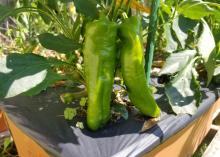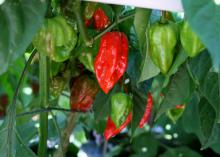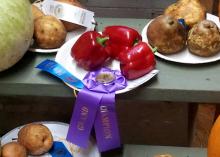Information Possibly Outdated
The information presented on this page was originally released on August 27, 2018. It may not be outdated, but please search our site for more current information. If you plan to quote or reference this information in a publication, please check with the Extension specialist or author before proceeding.
Hot and sweet peppers produce best in the fall
Several weeks ago, I wrote about looking forward to the time of year when ornamental peppers start strutting their gorgeous fruit colors. What I didn’t mention is that late summer is not just for ornamental peppers; I always get my best home-grown culinary peppers from August until frost in the fall.
My tastes for culinary peppers range from the mild and colorful bell peppers all the way to the superhot selections like Ghost, Scorpion and Carolina Reaper.
“Heat” is measured in units called Scovilles, named after Wilber Scoville, the scientist who developed the rating system.
Fruits of Capsicum, the botanical genus of all peppers, contain the compound capsaicin in varying concentrations. Capsaicin is the chemical compound that stimulates the nerve endings on our tongues to feel that “hot” sensation.
Capsaicin is concentrated in the inner white pith of the peppers. Contrary to popular belief, the seeds do not carry any heat, but since they are produced on those inner pith layers, they can be coated with the capsaicin.
Here’s a list of peppers and their heat content in Scovilles so you can put your own tolerance in perspective
Pepper Name |
Heat Content |
|---|---|
| Bell | 0 |
| Jalapeno | 2500 to 5000 |
| Serrano | 5,000 to 23,000 |
| Tabasco | 30,000 to 50,000 |
| Cayenne | 30,000 to 125,000 |
| Habanero | 100,000 to 350,000 |
| Ghost | 1,000,000 |
| Carolina Reaper | up to 2,200,000 (what I call weapons grade) |
Whether you like to eat them or not, I think peppers are interesting in their color development.
All the fruit start off green as they begin to grow. I get questions every year from people saying the tags with the pepper transplants I bought from the garden center say they’re supposed to be yellow or red, but the fruit is green. As they mature, the peppers develop the various colors they were bred to display.
One of my favorite ways to prepare and consume the peppers I grow is to fire roast them. This is a really easy way to upgrade your dining experience. Simply put your fresh peppers on a really hot grill until they develop a hard char. If you don’t want to use a grill, it works almost as well to place them under the broiler.
After the peppers are blackened, put them in a bowl and cover with plastic wrap. Their heat, in terms of temperature, releases steam. When cool, the blackened skin peels right off, and your peppers retain that smoky taste.
I love eating these right off the grill. But we also can them for use in the winter or to be ready for the zombie apocalypse, whichever comes first.
One of the best peppers I have grown in recent years is Giant Marconi. This is an elongated, Italian sweet pepper selection that tastes great and has no heat. The fruit is up to 8 inches long and has a smoky flavor without the need for the grill. I think they taste best when fully bright red.
Giant Marconi is an All-America Selection winner that produces strongly through the heat and humidity of our south Mississippi summer. I’m currently conducting a production trial with about 100 plants. Since mid-June, we’ve harvested five full 15-gallon containers of ripe and delicious fruit from these plants growing in Biloxi at the Mississippi State University Coastal Research and Extension Center.
I realize it’s too late to start peppers this season, but I hope you’ll consider growing peppers in your garden next year.






